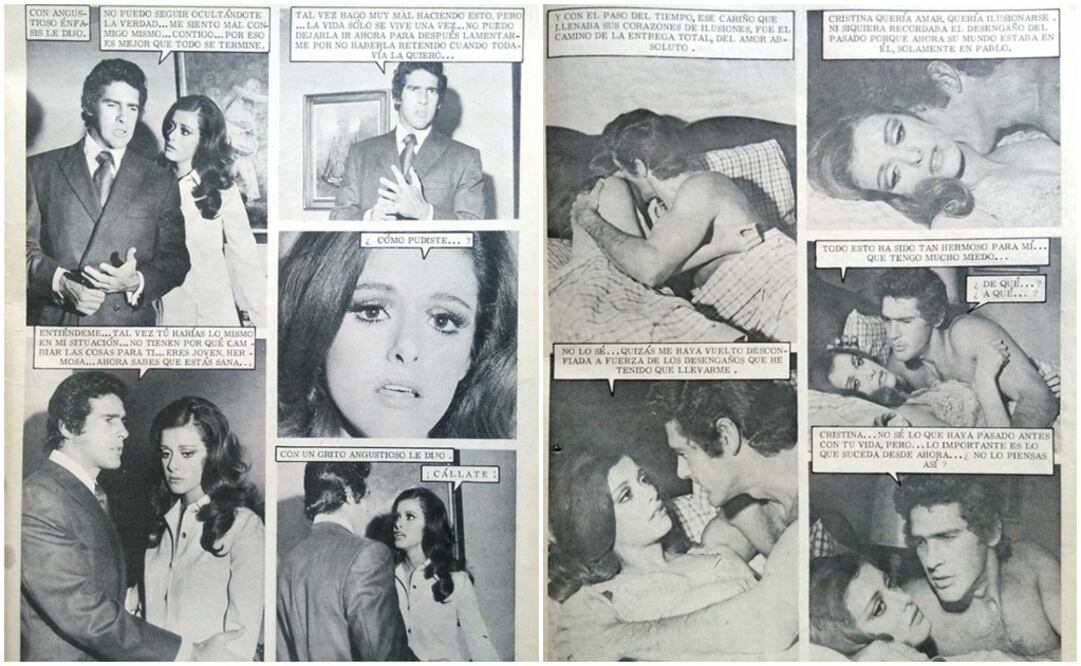Más Información

Corte atrae caso de Mario Aburto por asesinato de Colosio en 1994; revisará sentencia de 45 años de prisión

Partido Verde esperará iniciativa de reforma electoral para presentar su propuesta; Manuel Velasco destaca diálogo

Gertz comparecerá este jueves 22 de enero ante la Comisión permanente; se prevé que rinda protesta el próximo lunes

Colombia pasará a México presidencia pro tempore de Alianza del Pacífico el martes; mecanismo es la cuarta potencia exportadora mundial
"The luscious lips of the young lovers fused in a passionate kiss ," thus (after 16 pages overflowing of melodrama ), the love story was sealed. It was the photo-novel formula par excellence , a popular genre in Mexico between the 60s and 80s .
Photo-novel also known as photo comic is a sequential storytelling that uses photographs rather than illustrations, yet it complies with the usual comics conventions of narrative text and word balloons containing dialogue.
Photo-novels have been mainly used to adapt popular film and television works into print, but this genre has been used to tell original melodramas and provide medical education as well. Photo-novels were very popular in Italy ( fumetti ) and Latin America ( fotonovelas ), but they were known rather to a lesser extent in English-speaking countries.
In Mexico, fotonovelas were defined by a very particular language and loads of melodrama. In an interview with EL UNIVERSAL , Juan Antonio Edwards , a Mexican actor who appeared in more than 300 fotonovelas , assures: "The genre was sweeter than honey , with a pinch of naiveté , and a dash of cheesiness , yet I think that when you stop being corny you become too practical and there is not affection anymore."
The titles themselves portray the romanticism Edwards mentioned before: En la soledad contigo ( In Solitude with You ), Tus labios de sangre ( Your Crimson Lips ), El vino de la pasión ( Wine of Your Passion ), Cicatrices en el alma ( Scars in the Soul ), or Sed de cariño ( Thirst for Affection ).
Through its pages, the faces of those who would later become famous television and cinema actors and actresses paraded. Jorge Rivero, Jacqueline Andere, Julissa, Pepe Alonso, Rogelio Guerra, Ana Martín, Salvador Pineda, Victoria Ruffo, Julieta Rossen are some of the personalities that could be found in Mexico's fotonovelas.
According to Edwards, emotion, identity, and even a social situation can be conveyed only through your face. They had to portray certain scenarios by making specific facial expressions such as a scene captioned “ you're cheating on me ” or “ I love you .”
"A huge range of emotions was transmitted through fotonovelas," emphasized Edwards, yet it seems that the flair for melodrama died in Mexico at the same time that fotonovelas stopped being published in the 90s.
It seems that the high cost of paper was what led to the ending of the fotonovela era, yet the efforts to adapt stories that conquered television, such as Corazón salvaje ( Wild H eart ), were made but the fotonovelas did not gain any more popularity.
However, Edwards is working on a project to revive the genre in a digital format. "It's just a tribute to the fotonovelas. Currently, you sell copies on the Internet, yet they do not have the same impact anymore. Still, it's important to remember fotonovelas."
That same eagerness for the genre is what led Alejandro Luna , a Mexican hairdresser , to create the Facebook page Fotonovelas de México three years ago. Alandro Luna currently owns about 1,780 fotonovelas that were published between 1960 and 1992 .
Visit Fotonovelas de México Facebook page
sg
Noticias según tus intereses
[Publicidad]
[Publicidad]










